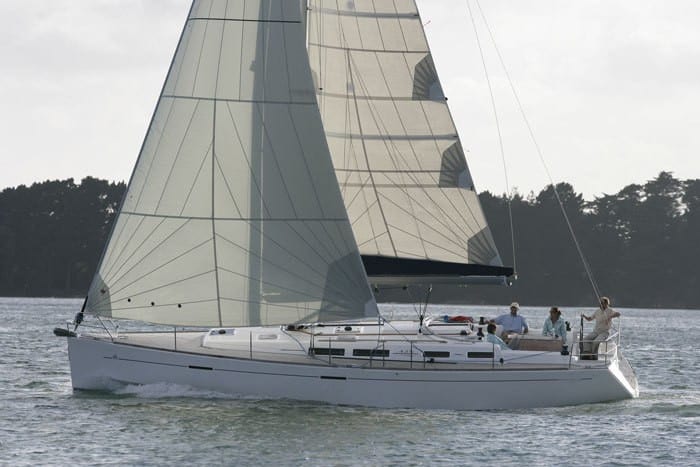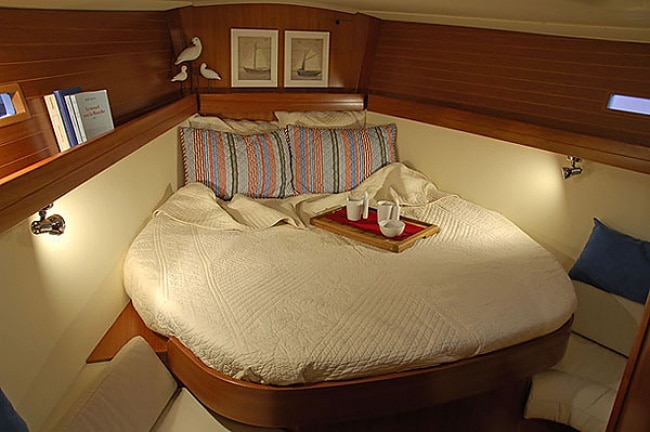
With the Dufour 425, the builder’s design team has delivered a modern-styled fast cruiser that targets the midsize market with touches of flair and performance. And after close scrutiny by Cruising World’s Boat of the Year judges during and after the U.S. Sailboat Show in Annapolis, I’d add that the crew at the factory in La Rochelle, France, has made big strides in quality control and boatbuilding efficiency.
The new boat’s plumb stem and relatively straight sheer hint at the raceboat demeanor and round-the-buoys reputation of the competitive Dufour 44. The 425 comes standard with a full-batten main and a boom-mounted sail pouch, but with a 5-foot-9-inch shoal-draft keel and an optional (at no extra cost), relatively benign fractional Sparcraft rig sporting both roller-furling jib and an in-mast furling mainsail, the 425 is clearly set up for ease of sailhandling rather than tweaked for speed. In other words, it’s a boat that’s designed for cruisers looking for a hint of performance to spice up their relaxation.
With a light-ship displacement of 18,700 pounds and a beam of 13 feet 8 inches, the Dufour 425 can be ranked as a high-volume, moderate-displacement cruiser, and designers Umberto Felci and Patrick Roséo have taken their Euro-styling pedigree to heart. The wide aft cockpit is augmented with a central table that acts as a good foot brace when beating to weather; a twin-wheel arrangement allows the helmsman to perch at either rail and trim a nearby jib sheet. Access from the transom remains wide open and allows a singlehander to quickly cover the distance between the helm and the mainsheet tailed to the cabin top.
Dufour’s latest approach to boatbuilding includes a focus on system installations and composite technology. Effective resin control was noticeable in lockers where the inner laminate skin could be seen. The company uses an NPG gelcoat, vinylester resin, and PVC foam core in the hull laminate, and it employs polyester resin in the deck. The deck is built via a resin-injection molding process that incorporates a double-sided mold. One of the big upsides associated with this method is the ability to achieve two finished surfaces and eliminate the need for an under-deck liner to hide the rough surface associated with single-sided molds. We did notice some deck flex and squeaking on the port side near the aft part of the cabin house, which may have been due to an incomplete bond to the bulkhead below.
Twaron, a para-aramid fiber akin to Kevlar, is used in the keel-attachment area, and its high-tensile strength helps to spread the ballast and other global loads in this highly stressed region. The chainplates are connected to the hull via a tie-rod-and-toggle arrangement that’s attached to a stainless-steel bar held in an FRP laminate. The engineering and structural attention to detail in this part of the boat is quite effective, and rig loads from both the chainplates and the mast’s compression post are shared by an FRP grid structure. The iron keel is attached with stainless-steel bolts, and the rudderstock is also stainless steel.

The Dufour 425 comes in either a two- or three-cabin layout; we sailed the latter. The vessel’s wide stern provides room for smaller aft cabins, both with double berths, a head, and a good-size chart table. The galley, with outboard sinks, resides amidships and is located to port with a dinette to starboard. I’d prefer a more traditional U- or L-shaped galley with midline sinks for going to sea. A double-berth cabin with a head and shower occupies the forward end of the boat. The tight turn of the bilge limits stowage under the cabin sole, and although there’s lots of volume in the form of cabin space, storage for long-range cruising is a bit limited. Dufour offers an optional layout that solves this problem by eliminating one of the aft cabins and making it akin to a storeroom.
A 40-horsepower Volvo saildrive comes as standard propulsion; a 55-horse motor is optional. The engine was neatly installed, and the plumbing and wiring were done to ISO standards. One of the big plusses in the boat’s design is the easy access to the raw-water and coolant pumps and the alternator-items that occasionally need attention, often at inconvenient times.
One of the most notable traits of the Dufour 425 was the attention to detail we saw in such features as wiring and the electrical distribution panel. For example, leads were effectively bundled and strapped into place in a manner that will minimize chafe, and tinned wire was used throughout the electrical system. Plumbing runs were also carefully connected and led in a sensible fashion.
Under way, the roller-furling mainsail didn’t have a lot of punch in light air. The sails on the boat we tested were easy to handle, but the trade-off invoked by the shallow-roach main was less-than-rousing light-air performance. A conventional mainsail with more roach would’ve been a better alternative. Even so, when we did see a puff, the Dufour quickly accelerated and scooted along at better than 5 knots in 9 to 10 knots of breeze. Those looking to up the go-fast factor, especially in light air, and those interested in doing a bit of club racing would indeed benefit from the deeper fin-keel option (with a draft of 6 feet 11 inches) and a conventional mainsail.
Under power, the Volvo saildrive pushed the boat at 2,500 rpm to 7.8 knots, better than hull speed, and did so with low vibration and a moderate noise rating (88 decibels). The twin Lewmar wheels provided good visibility for the helmsmen, although I could feel the extra drag of the unused wheel when maneuvering.
Some will appreciate the Dufour 425’s racy bent, but for cruising, I’d prefer to see a handrail forward of the mast. And when retrieving the anchor, it was hard not to brush it against the plumb bow, even with a great double-slotted bow roller. Most owners choose a stainless-steel bow protector to prevent nicks in the bow.
We also noticed that the genoa sheets caught on athwartships opening hatches. Of course, those hatches would still help provide ventilation when in port. A sensible alternative would be the addition of good-size dorade vents.
That said, the Dufour 425 is a fast, modern cruiser with good passagemaking potential and a good comfort quotient for when you arrive in the next port, ahead of your crowd. It has large, well-secured cleats, a dedicated life-raft locker, and hard points in the cockpit on which to fasten harness tethers-all features I’d look for in a boat that I might take cruising.
Ralph Naranjo, a frequent CW contributor, was a 2008 Boat of the Year judge.








